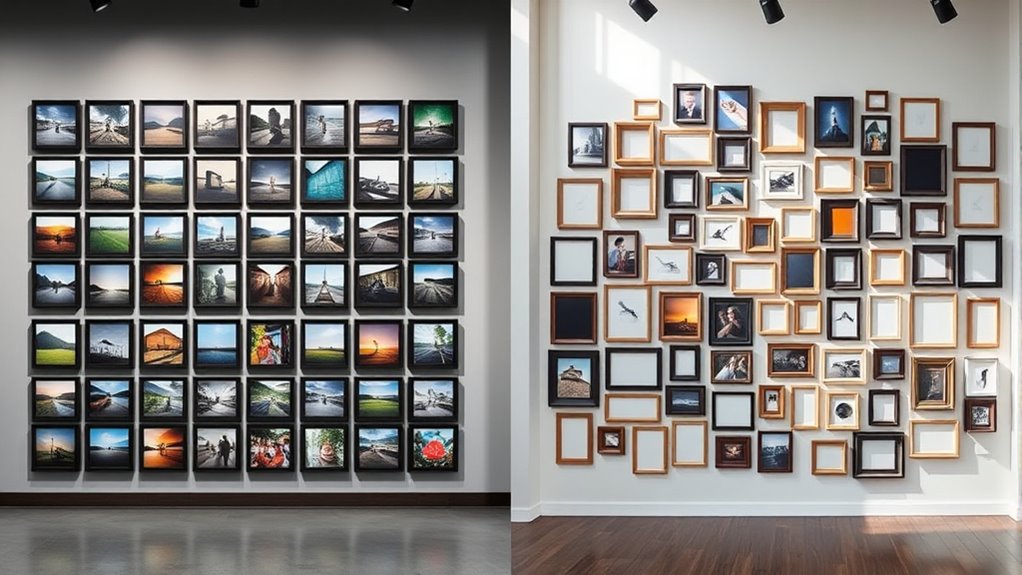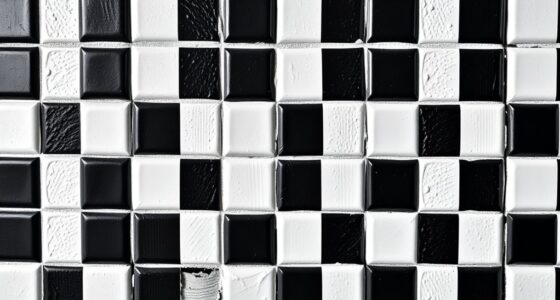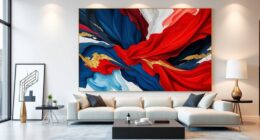If you want a clean, structured look with symmetry, opt for grid walls—they’re perfect for modern, organized spaces like living rooms or above sofas. For a more eclectic, personalized vibe, gallery walls work well in bedrooms, hallways, or areas where you want to showcase your personality with varied frames and artwork. Choosing the right style depends on your aesthetic goals and space needs, and exploring further reveals how to make each option shine in your home.
Key Takeaways
- Use grid walls for structured, uniform displays in focal areas like living rooms or above sofas to create a cohesive look.
- Opt for gallery walls in eclectic spaces, narrow hallways, or personal areas like bedrooms to showcase personality and varied artwork.
- Choose grid walls for easy reconfiguration of collections and functional setups with shelves or hooks; select gallery walls for creative storytelling.
- Grid walls work well in modern or minimalist decor styles, while gallery walls complement eclectic, bohemian, or personalized aesthetics.
- Use grid walls for organized, symmetrical displays; prefer gallery walls for diverse, visually dynamic arrangements with varied frame styles.
Defining Grid Walls and Gallery Walls
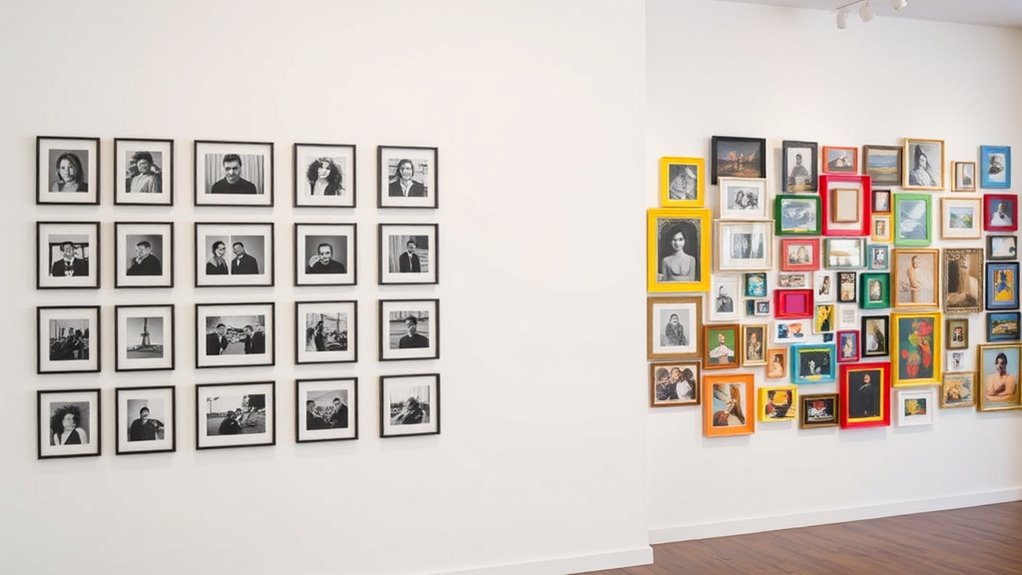
Have you ever wondered what sets grid walls apart from gallery walls? Grid walls feature a structured, geometric layout with evenly spaced openings, creating a clean, organized look. Wall spacing is consistent, making it easy to align frames or decor items neatly. On the other hand, gallery walls are more eclectic, with varied spacing and a mix of frame styles that add personality and character. Gallery walls often showcase different frame styles, sizes, and orientations, giving a curated, layered appearance. While grid walls emphasize symmetry and order, gallery walls focus on visual interest and personal expression. Understanding these distinctions helps you choose the right wall type for your space, based on your preferred style and how much variation you want in frame styles and spacing. Additionally, considering wall decor can help you achieve the desired ambiance, whether rustic farmhouse or modern eclectic. Incorporating contrast and balance can further enhance the visual appeal of your chosen wall arrangement. Recognizing decor style preferences can guide you in selecting the most suitable wall type to complement your overall interior design.
Visual Style and Aesthetic Appeal
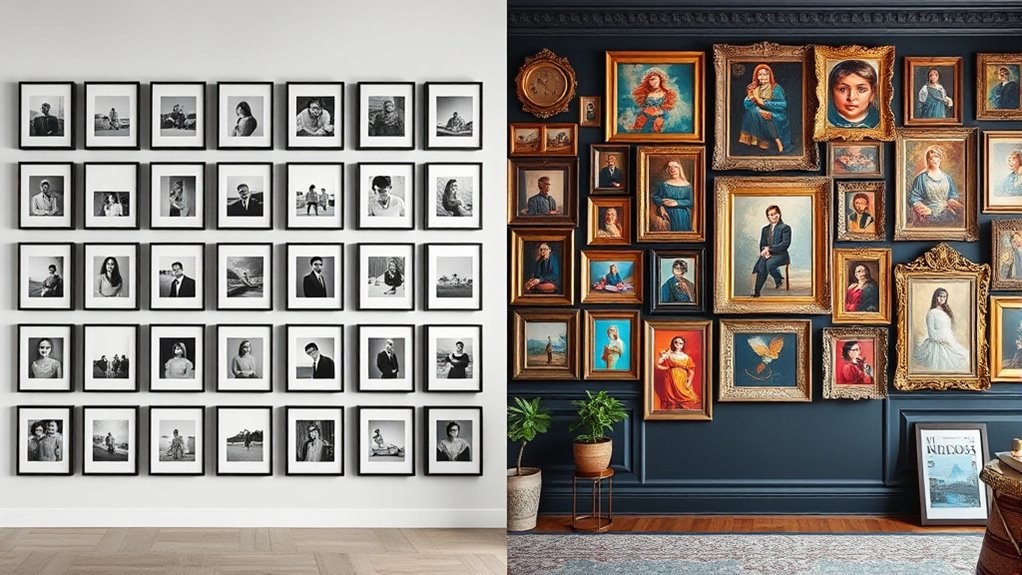
Your choice between grid walls and gallery walls considerably affects the room’s visual style and overall aesthetic. A grid wall offers cohesion and balance, creating a clean, orderly look, while a gallery wall delivers a bold visual impact and draws focus to specific pieces. Understanding these differences helps you craft a space that best reflects your style and enhances its aesthetic appeal. Additionally, selecting the right decorative style can influence how each wall type complements your overall interior design. For example, choosing a traditional Italian design can add warmth and timeless charm to either wall style, emphasizing cultural motifs and craftsmanship. Recognizing the role of visual harmony in your wall arrangement can further ensure your space remains cohesive and engaging, especially when aligning with vibrational energy principles that support a positive and inspiring environment.
Cohesion and Balance
When it comes to creating a cohesive and balanced display, both grid walls and gallery walls have unique strengths that influence their visual style and aesthetic appeal. A grid wall naturally emphasizes cohesion through color coordination and frame consistency, creating a uniform look that feels orderly and harmonious. This approach helps your space appear clean and intentional, with each piece complementing the others. Conversely, gallery walls offer more flexibility in balancing visual weight; you can mix different frame styles and colors while still maintaining overall harmony through strategic placement. To achieve cohesion, guarantee your frames are consistent or coordinate your color palette. Balance is maintained by thoughtfully arranging pieces so no single area feels heavy, creating an inviting, well-composed display. Incorporating Vetted product reviews can also guide you in selecting complementary frames and decor to enhance your overall arrangement. Additionally, understanding visual balance principles can help in arranging your artwork to create a pleasing and stable visual composition. Recognizing the importance of color harmony can further enhance the unified appearance of your display. Incorporating design principles like repetition and contrast can also strengthen the overall cohesion of your wall arrangement.
Visual Impact and Focus
The visual impact of a grid wall and a gallery wall profoundly shapes the overall aesthetic of your space. With a grid wall, your focus is on uniformity, sharp lines, and cohesive color coordination, creating a sleek, modern look. A gallery wall offers more flexibility, allowing varied frame styles and art pieces that draw attention and add personality. To enhance visual style and focus: 1. Use consistent or complementary colors to unify the display. 2. Incorporate varied frame sizes for visual interest. 3. Consider lighting considerations—spotlights or ambient lighting highlight focal points. 4. Balance artwork placement to draw eyes naturally across the arrangement. Your choice influences how the space feels—clean and orderly or lively and eclectic. Additionally, paying attention to the visual impact of your arrangement can help reinforce the desired atmosphere and style in your space. Being aware of aesthetic principles can further guide your design choices for a more cohesive look. Incorporating personality traits such as your preferred style or mood can also personalize the display to better reflect your space’s character. Furthermore, understanding visual harmony ensures that all elements work together seamlessly, enhancing the overall aesthetic appeal.
Ideal Spaces for Each Display Type
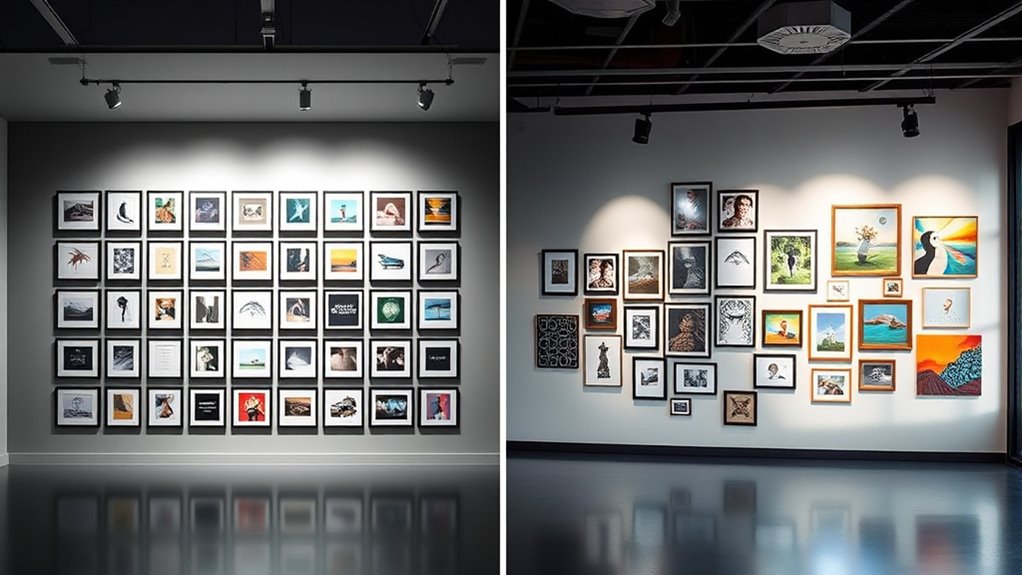
Your living room’s focal point is perfect for a grid wall, creating a striking centerpiece. Narrow hallways and corridors benefit from gallery walls, adding visual interest without overwhelming the space. In bedrooms, gallery walls can enhance the decor, making the room feel more personalized and cozy. Knowing store hours can help plan shopping trips for frames and wall decor to complete your display. Additionally, understanding branding and marketing strategies can inspire creative ways to showcase your personal style through wall arrangements. Incorporating dog names into your decor themes, such as personalized wall art featuring your dog’s name, can add a charming and unique touch to your space. Considering wall placement and lighting options can further elevate your chosen display style for maximum impact.
Living Room Focal Points
Ever wondered where to best showcase your wall displays in the living room? Your focal points are perfect spots to highlight artistic expression and create spatial harmony. Consider these areas:
- Above the sofa, serving as a central anchor that draws attention.
- Behind a coffee table, framing the main seating area with visual interest.
- At the end of a wall, balancing the room’s proportions and guiding the eye.
- Along a large, empty wall, transforming it into a statement piece. Incorporating wall arrangement techniques can enhance the overall aesthetic and ensure a cohesive look.
- Think about the architectural significance of your space, as certain focal points can enhance the room’s design narrative.
- In spaces with natural light, positioning displays to maximize illumination can make the artwork or decor stand out more vividly. Additionally, considering digital literacy programs can help you better understand how to incorporate technology, like digital displays or smart frames, into your wall arrangements.
Narrow Hallways and Corridors
Narrow hallways and corridors offer unique opportunities for wall displays, allowing you to add visual interest without overwhelming tight spaces. To make the most of these areas, consider lighting techniques that brighten the space and create a welcoming atmosphere. Spotlights or wall-mounted sconces can highlight artwork or decorative elements, making the corridor feel more open. When choosing between grid walls and gallery walls, a grid wall with its sleek, organized layout works well in narrow spaces, providing structure without clutter. Pay attention to color coordination; sticking with light or neutral tones can make the corridor appear larger, while bold accents add personality. Keep decorations minimal and well-spaced to avoid visual overload, ensuring your hallway remains functional yet stylish.
Gallery Walls in Bedrooms
Gallery walls in bedrooms create a personalized focal point that reflects your style and memories. They work best in spaces where you want to showcase your personality and elevate your bedroom decor. Imagine a wall behind your bed displaying:
- Family photos capturing special moments
- Art pieces that inspire you daily
- Travel souvenirs that spark adventure
- Favorite quotes or affirmations in stylish frames
These elements turn a plain wall into a reflection of your personal expression. Use a gallery wall to add visual interest and create a cozy, inviting atmosphere. It’s ideal when you want a versatile display that can evolve over time. In bedrooms, gallery walls serve as a meaningful backdrop, making your space uniquely yours. Incorporating personalized decor can further enhance the intimate feel of your bedroom.
Flexibility and Customization Options
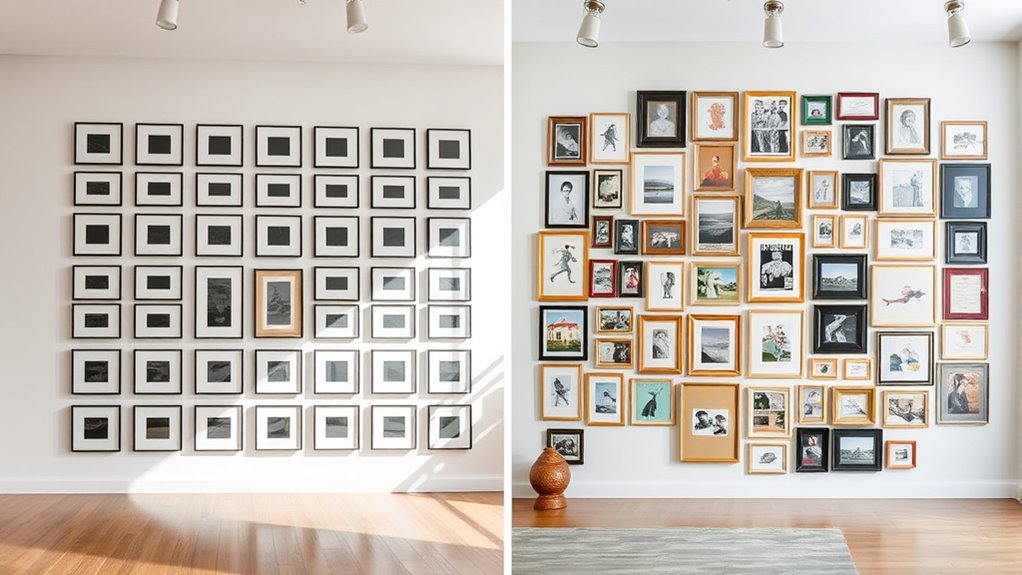
When it comes to flexibility and customization, grid walls and gallery walls each offer unique advantages. Grid walls provide a highly adaptable framework that allows you to easily rearrange or swap out individual elements, making them ideal for ongoing artistic expression. You can add shelves, hooks, or panels to suit changing needs or styles, giving you greater spatial adaptability. Gallery walls, on the other hand, enable you to curate a specific visual story with varied artwork or photos, which can be customized in size, shape, and arrangement. They offer a more personal touch, reflecting your taste and personality. While grid walls excel in functional versatility, gallery walls shine in creative expression and aesthetic flexibility. Both options empower you to tailor your space to your evolving vision.
Ease of Installation and Maintenance
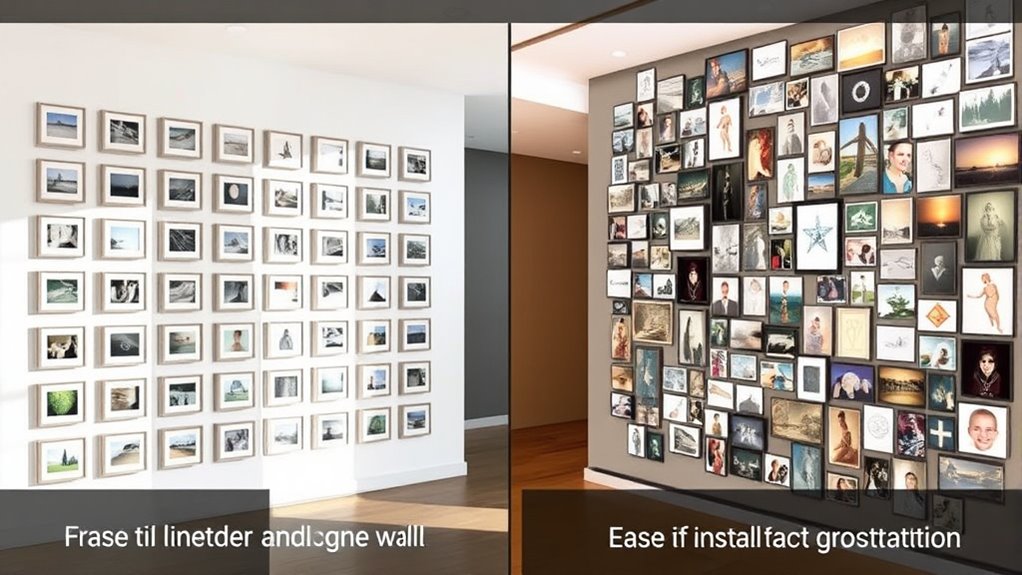
Installing grid walls is generally straightforward because they come with modular panels and clear mounting instructions, allowing you to set them up with basic tools and minimal effort. This design offers high installation simplicity, making it accessible even if you’re new to wall setups. Maintenance is equally easy, thanks to their durable materials that resist dust and damage. To keep your grid wall in top shape, consider these steps:
- Regularly wipe down panels with a damp cloth.
- Check and tighten any loose connectors or screws.
- Remove and replace damaged panels promptly.
- Keep the area around the wall clean to prevent dust buildup.
These steps ensure your grid wall remains functional and attractive, highlighting its maintenance ease and user-friendly design.
Best Uses for Personal Collections and Art
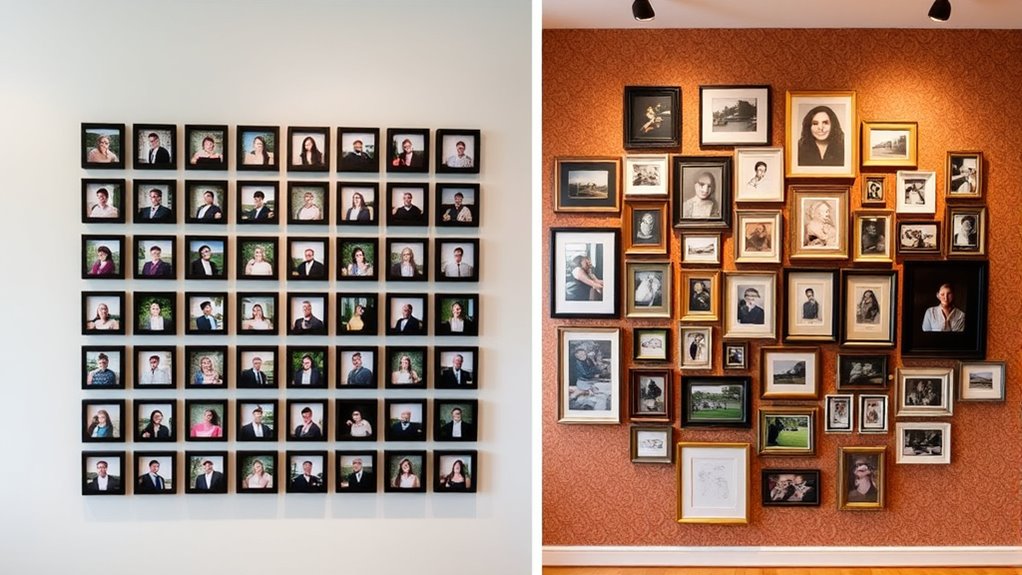
Personal collections and art are best showcased on grid walls because their modular design allows you to customize and easily rearrange displays. With grid walls, you can adapt your setup to match your wall color, whether you prefer a bold contrast or a subtle tone, enhancing your artwork’s impact. Lighting choices are also easier to optimize, as the open structure lets you add focused lighting or spotlights to highlight specific pieces. This flexibility helps create a dynamic display that reflects your personality. Whether you’re showcasing photos, collectibles, or artwork, a grid wall makes it simple to maintain a fresh, personalized look. Its versatility ensures your collection stays organized and visually appealing, no matter how often you update or expand it.
Creating a Cohesive Look in Different Rooms
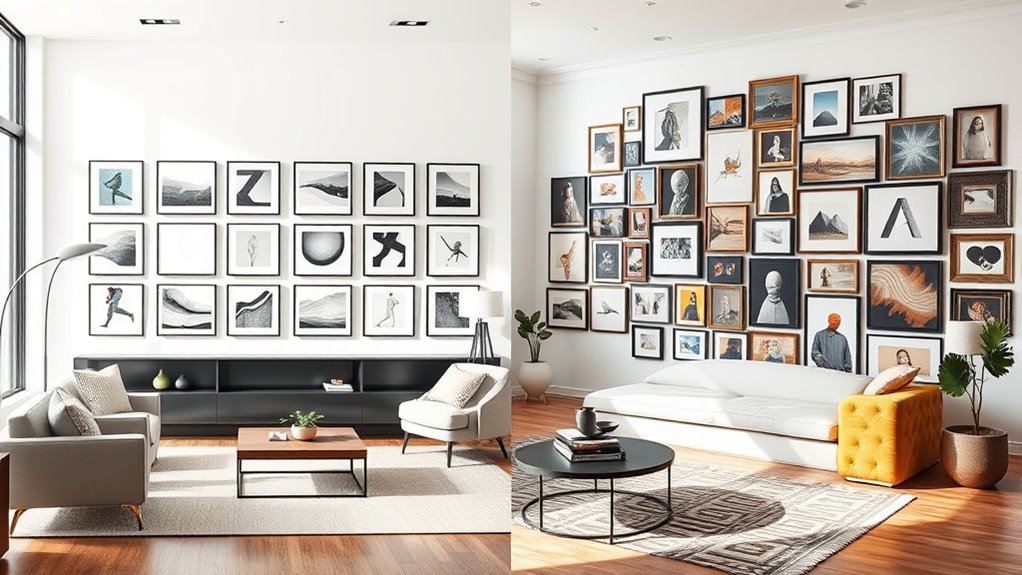
Achieving a cohesive look across different rooms starts with choosing a consistent display style that ties the spaces together. First, select a unified color scheme that complements your overall decor, creating visual harmony. Second, consider lighting considerations—use similar lighting fixtures or bulbs to guarantee consistent warmth and brightness. Third, maintain a similar framing style or matting for your artwork or photos, which helps unify diverse pieces. Fourth, think about the scale of your displays; balancing sizes keeps the overall flow seamless. Whether you opt for grid walls or gallery walls, these elements create a cohesive look, making your home feel thoughtfully curated and harmonious from room to room.
Tips for Combining Both Styles Effectively

Combining grid walls and gallery walls can create an engaging and dynamic display that highlights your personal style. To do this effectively, consider your lighting techniques—use focused lighting to emphasize key pieces or softer ambient lighting for a warm, inviting feel. Play with framing styles to add variety; mix sleek, modern frames with ornate or distressed options to create visual interest. Keep a balance by ensuring the grid wall’s uniformity complements the more eclectic gallery wall. You might also align the spacing between artworks or frames to maintain cohesion. Remember, the goal is harmony. With thoughtful lighting and carefully chosen framing styles, you can blend these two wall art styles seamlessly, making your space both functional and visually mesmerizing.
Frequently Asked Questions
How Do I Choose Between Grid Walls and Gallery Walls for My Space?
You should choose a grid wall if your decor style is modern or minimalist, and your space is smaller, as it creates a clean, organized look without clutter. Opt for a gallery wall if you want to showcase your personality, have a larger space, or prefer a more eclectic, personalized vibe. Consider your room size and decor style to select the one that best enhances your space’s overall aesthetic.
Can I Mix Grid and Gallery Wall Styles on the Same Wall?
Yes, you can mix grid and gallery wall styles on the same wall to create artistic balance and enhance spatial harmony. To do this effectively, vary frame sizes and spacing, blending structured grid lines with eclectic arrangements. Keep a cohesive color palette or theme to unify the diverse styles. This approach adds visual interest while maintaining harmony, making your wall a personalized, dynamic focal point that reflects your unique taste.
What Are the Cost Differences Between Installing Grid Walls and Gallery Walls?
Think of grid walls as a sturdy backbone and gallery walls as a vibrant canvas. Installation costs for grid walls tend to be higher due to their durable metal frames, while material expenses for gallery walls vary based on frame quality and artwork. Overall, grid walls usually cost more upfront because of hardware and installation, but gallery walls can be more budget-friendly, especially if you reuse frames or opt for DIY options.
Are There Specific Wall Types Better Suited for Each Display Style?
You’ll find that grid walls work best on sturdy wall materials like drywall or concrete, especially in well-lit rooms where their structure can be showcased. Gallery walls suit smooth, paintable surfaces like plaster or drywall, allowing you to arrange frames easily. Consider room lighting too; bright areas highlight the arrangement, while dimmer spaces may benefit from the clean, minimal look of a grid wall.
How Do Lighting Considerations Differ for Grid and Gallery Wall Displays?
You should consider lighting intensity and spotlight placement carefully for each display style. For grid walls, opt for brighter lighting to highlight the uniform arrangement, and position spotlights evenly across the grid to avoid shadows. For gallery walls, softer lighting works better to create a cozy, inviting ambiance, with spotlights directed at individual pieces to emphasize details without overwhelming the overall display. Adjust lighting to enhance each wall’s unique aesthetic.
Conclusion
Whether you choose grid walls or gallery walls, think of them as the heartbeat of your space—each telling its own story. With a little creativity, you can weave these styles into a vibrant tapestry that reflects your personality. Imagine your walls as a blank canvas, ready to burst into a symphony of colors and shapes. Embrace the journey of curating your perfect display, and watch your walls transform into a gallery of your life’s most cherished moments.
